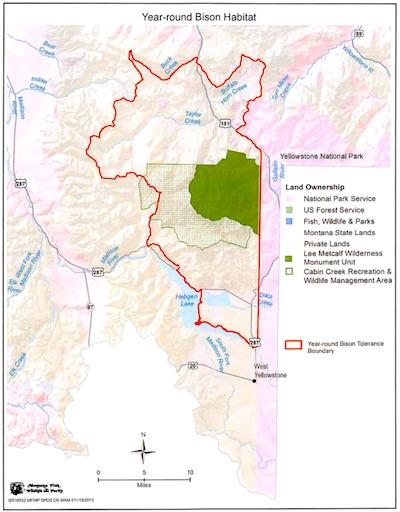
A plan approved by Montana officials would provide about 400 square miles of land outside of Yellowstone National Park for park bison to roam onto/Montana
Yellowstone National Park bison soon are expected to be allowed to roam into parts of Montana under a plan approved by Gov. Steve Bullock, yet it remains to be seen how much relief it provides the iconic animals as they head to their traditional wintering and calving grounds.
The governor's decision -- which must be approved by other stakeholders that oversee the Interagency Bison Management Plan -- would open up year-round access for bulls and cows to Horse Butte, and along U.S. 191 up to and including the Taylor Fork drainage. It also provides year-round access for bulls to the Gardiner Basin north of the park up to the southern end of Yankee Jim Canyon. All told, the plan would open about 400 square miles of lands in Montana to free-roaming Yellowstone bison.
“An adaptive approach to bison management means we look at how we are doing things, assess our effectiveness, and adapt accordingly,” Gov. Bullock said in a release. “This decision is a very modest expansion of the conditions under which bison may remain outside of the park, in response to changing science and changing circumstances on the ground. While at the same time I am confident our livestock industry is protected. Further, I remain committed to continuing to pressure the Park Service to reduce the bison population in the Park, and keep those numbers to manageable levels.”
The Horse Butte area on the west side of the park became available for bison through a land ownership change, along with the closing of several grazing allotments in the national forest there. Under the plan, the number of bison allowed to roam in this area would vary by season, from a low of 250 during the summer months to 600 in the spring.
"This decision acknowledges that bison are nomadic in nature, and they will move in and out of Montana in varying numbers depending on the population size, time of year, and environmental conditions," the decision document said. "The largest migration has historically occurred in the spring as bison seek the early green up conditions that occur in the Hebgen Basin."
Montana officials have reserved the right to manage bison in these areas if needed, either through hazing, culling, or hunting.
While the lands to the west of Yellowstone have been important for bison in winter and spring, those lands to the north are even more important as the park's largest bison herd roams the northern range of Yellowstone.
“The northern herd is bigger than it ever has been before," Yellowstone Superintendent Dan Wenk told the Traveler earlier this month. "There’s been a movement, a shift if you will. The largest herd used to be the central herd that wintered in the Hayden Valley. It moved to the west. The shift has been to the northern herd, which is about 3,500 animals. The central herd is about 1500 animals. That used to be flipped.”
There's more than ample room in Yellowstone for the current bison population, which is estimated at around 5,000 animals. Superintendent Wenk said the park's carrying capacity is probably around 7,000 bison.
"But, please understand, they cannot winter 100 percent in the park," he pointed out. "We don’t believe we have a problem with the ecology in the park, based on the herd size today, but there’s very little space for them to go outside the park."
As efforts continue to evolve the bison management plan, the one factor that won't change is that Yellowstone can't exist as a biological island for the bison, the superintendent said.
“That is the bottom line. I think there is recognition of that, even though we do say, and it is true, that it is the largest nearly intact ecosystem in the temperate zone of, maybe it's in the world , certainly the United States," Superintendent Wenk said. "It’s not big enough. Whether it’s bison, whether it’s elk, whether it’s grizzly bears, any animal, basically they do migrate out in the winter due to the depth of the snow.”




 Support Essential Coverage of Essential Places
Support Essential Coverage of Essential Places






